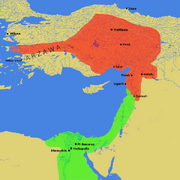The Nineteenth Dynasty of ancient Egypt (notated Dynasty XIX)[1] was one of the periods of the Egyptian New Kingdom. Founded by Vizier Ramesses I, whom Pharaoh Horemheb chose as his successor to the throne, this dynasty is best known for its military conquests in modern Israel, Lebanon, and Syria.
The warrior kings of the early 18th Dynasty had encountered only little resistance from neighbouring kingdoms, allowing them to expand their realm of influence easily. The situation had changed radically towards the end of the 18th Dynasty. Helped by Akhenaten's apparent lack of interest in international affairs, the Hittites gradually extended their influence into Syria and Palestine to become a major power in international politics, a power that both Seti I and his son Ramesses II would need to deal with.
The Pharaohs of the 19th Dynasty[]
The pharaohs of the 19th dynasty ruled from approximately one hundred and ten years: from ca 1298 to 1187 BCE. The dates and names in the table are taken from Dodson and Hilton. [2]. Many of the pharaohs were buried in the Valley of the Kings in Thebes (designated KV). More information can be found on the Theban Mapping Project website. [3]
| name of King | Horus (Throne) Name | date | Burial | Queen(s) |
|---|---|---|---|---|
| Ramesses I | Menpehtire | 1298 - 1296 BCE | KV16 | Sitre |
| Seti I | Menmaetre | 1296 - 1279 BCE | KV17 | (Mut-)Tuya |
| Ramesses II | Usermaatre Setepenre | 1279 - 1212 BCE | KV7 | Nefertari Isetnofret Maathorneferure Meritamen Bintanath Nebettawy Henutmire |
| Merneptah | Banenre | 1212 - 1201 BCE | KV8 | Isetnofret II |
| Seti II | Userkheperure | 1201 - 1195 BCE | KV15 | Twosret Takhat |
| Amenmesse | Menmire-Setepenre | 1200 - 1196 BCE | KV10 | ?? |
| Siptah | Sekhaenre / Akheperre | 1195 - 1189 BCE | KV47 | |
| Queen Twosret | Sitre-Merenamun | 1189 - 1187 BCE | KV14 |
Seti I and Ramses II[]

Egyptian and Hittite Empires, around the time of the Battle of Kadesh (1274 BCE).
New Kingdom Egypt reached the zenith of its power under Seti I and Ramesses II ("The Great"), who campaigned vigorously against the Libyans and the Hittites. The city of Kadesh was first captured by Seti I before this king decided to concede it to Muwatalli of Hatti in an informal peace treaty between Egypt and Hatti. Ramesses II later attempted unsuccessfully to alter this situation in his fifth regnal year by launching an attack on Kadesh in his Second Syrian campaign in 1274 BCE, and was caught in history's first recorded military ambush, but thanks to the arrival of the Ne'arin, Ramesses was able to rally his troops and turn the tide of battle against the Hittites. Ramesses II later profited from the Hittites' internal difficulties during his eighth and ninth regnal years, when he campaigned against their Syrian possessions, capturing Kadesh and portions of Southern Syria, and advancing as far north as Tunip where no Egyptian soldier had been seen for 120 years. He ultimately accepted that a campaign against the Hittites was an unsupportable drain on Egypt's treasury and military.[4] In his 21st regnal year, Ramesses signed the first recorded peace treaty with Urhi-Teshub's successor, Hattusili III and with that act Egypt-Hittite relations improved significantly. Ramesses II even married two Hittite princesses, the first after his second Sed Festival. At least as early as Josephus, it was believed that Moses lived during the reign of Ramesses II (though a wide range of other possibilities has also been suggested).
Merneptah[]
This dynasty declined as internal fighting between the heirs of Merneptah for the throne increased. Amenmesse apparently usurped the throne from Merneptah's son and successor, Seti II, but he ruled Egypt for only four years. After his death, Seti regained power and destroyed most of Amenmesse's monuments. Seti was served at Court by Chancellor Bay, who was originally just a 'royal scribe' but quickly became one of the most powerful men in Egypt gaining the unprecedented privilege of constructing his own tomb in the Valley of the Kings (KV17). Both Bay and Seti's chief wife Twosret reportedly had a sinister reputation in Ancient Egyptian folklore.[5] After Siptah's death Twosret ruled Egypt for two more years, but she proved unable to maintain her hold on power amid the conspiracies and powerplays being hatched at the royal court. She was likely ousted in a revolt led by Setnakhte, founder of the Twentieth Dynasty.
Nineteenth Dynasty timeline[]

References[]
- ↑ Kuhrt, Amélie (1997). The Ancient Near East. London: Routledge. pp. 188. http://books.google.co.uk/books?id=V_sfMzRPTgoC&pg=PA188&dq=Egypt+Dynasty+XIX&ei=Qo36S8TbCIiEyQTXhpGeCw&cd=6#v=onepage&q=Egypt%20Dynasty%20XIX&f=false.
- ↑ Aidan Dodson, Dyan Hilton: The Complete Royal Families of Ancient Egypt. The American University in Cairo Press, London 2004
- ↑ Sites in the Valley of the Kings
- ↑ N. Grimal, A History of Ancient Egypt (Oxford: Blackwell, 1992), pp. 256f.
- ↑ Grimal, p. 270
| This page uses content from the English Wikipedia. The original article was at Nineteenth dynasty of Egypt. The list of authors can be seen in the page history. |